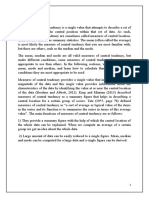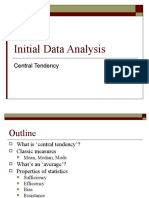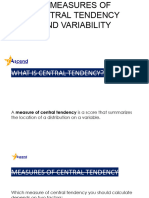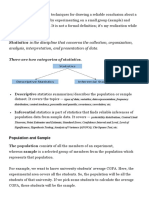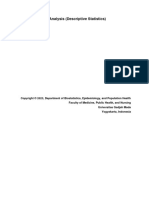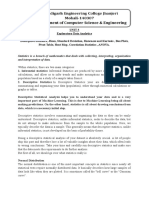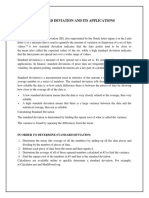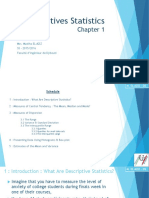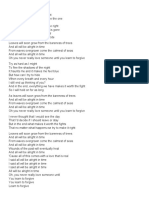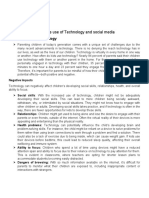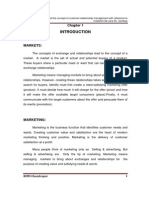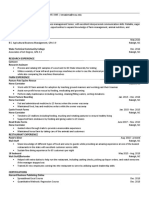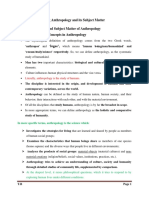0 ratings0% found this document useful (0 votes)
49 viewsProfed 10
Profed 10
Uploaded by
Junel SildoThe document discusses measures of central tendency and variation used to assess student performance. It defines mean, median, and mode as the three main measures of central tendency, and explains how to calculate and when to use each. It also defines range, interquartile range, variance, standard deviation, and mean deviation as key measures of variation, providing the formulas to compute variance and standard deviation. The document advises using the median as the best measure of central tendency when data contains extreme scores, as it is not affected by outliers like the mean.
Copyright:
© All Rights Reserved
Available Formats
Download as DOCX, PDF, TXT or read online from Scribd
Profed 10
Profed 10
Uploaded by
Junel Sildo0 ratings0% found this document useful (0 votes)
49 views4 pagesThe document discusses measures of central tendency and variation used to assess student performance. It defines mean, median, and mode as the three main measures of central tendency, and explains how to calculate and when to use each. It also defines range, interquartile range, variance, standard deviation, and mean deviation as key measures of variation, providing the formulas to compute variance and standard deviation. The document advises using the median as the best measure of central tendency when data contains extreme scores, as it is not affected by outliers like the mean.
Original Title
profed10.docx
Copyright
© © All Rights Reserved
Available Formats
DOCX, PDF, TXT or read online from Scribd
Share this document
Did you find this document useful?
Is this content inappropriate?
The document discusses measures of central tendency and variation used to assess student performance. It defines mean, median, and mode as the three main measures of central tendency, and explains how to calculate and when to use each. It also defines range, interquartile range, variance, standard deviation, and mean deviation as key measures of variation, providing the formulas to compute variance and standard deviation. The document advises using the median as the best measure of central tendency when data contains extreme scores, as it is not affected by outliers like the mean.
Copyright:
© All Rights Reserved
Available Formats
Download as DOCX, PDF, TXT or read online from Scribd
Download as docx, pdf, or txt
0 ratings0% found this document useful (0 votes)
49 views4 pagesProfed 10
Profed 10
Uploaded by
Junel SildoThe document discusses measures of central tendency and variation used to assess student performance. It defines mean, median, and mode as the three main measures of central tendency, and explains how to calculate and when to use each. It also defines range, interquartile range, variance, standard deviation, and mean deviation as key measures of variation, providing the formulas to compute variance and standard deviation. The document advises using the median as the best measure of central tendency when data contains extreme scores, as it is not affected by outliers like the mean.
Copyright:
© All Rights Reserved
Available Formats
Download as DOCX, PDF, TXT or read online from Scribd
Download as docx, pdf, or txt
You are on page 1of 4
Christ the King College
College of Teacher Education
Prof. Ed 10
Assessment of Learning 2
Name: Judy Joyce B. Bartolome
Time: T/TH 1:00-2:30 pm
1. What is the importance of the different measures of central
tendency in assessing the performance of the students?
Answer: Central tendency is very useful in assessing the
performance of the students. It lets us know what is normal or
'average' for a set of data. It also condenses the data set down
to one representative value, which is useful when you are
working with large amounts of data. Measures of Central Tendency
provide a summary measure that attempts to describe a whole set
of data with a single value that represents the middle or centre
of its distribution. There are three main measures of central
tendency: the mean, the median and the mode.
When data is normally distributed, the mean, median and mode
should be identical, and are all effective in showing the most
typical value of a data set. It's important to look
the dispersion of a data set when interpreting the measures of
central tendency.
2. When do we use mean, median, and mode?
Answer: The mean is usually the best measure of central
tendency to use when your data distribution is continuous and
symmetrical, such as when your data is normally distributed.
However, it all depends on what you are trying to show from your
data. On the other hand, when the sample size is large and does
not include outliers, the mean score usually provides a better
measure of central tendency. “(Then goes on to give an example
of when the median is better.) “Use the median to describe the
middle of a set of data that does have an outlier. Again, it
depends on the question you are asking of the data, however, if
you question is "what is the average salary" in terms of "what
is the typical salary of an employee," then median would be a
much better measure than the mean. As we will find out later,
taking the median would be a better measure of central
tendency in this situation. Another time when we usually prefer
the median over the mean (or mode) is when our data is skewed
(i.e., the frequency distribution for our data is skewed).
3. What are the properties of mean, median, and mode?
Answer:
Properties of Mean
• It measures stability. Mean is the most stable among
other
measures of central tendency because every score contributes
to the value of the mean.
• It may easily affected by the extreme scores.
Properties of the Mean
• The sum of each score’s distance from the mean is zero.
• It may not be an actual score in the distribution.
• It can be applied to interval level of measurement.
• It is very easy to compute.
Properties of Median
• It may not be an actual observation in the data set.
• It can be applied in ordinal level.
• It is not affected by extreme values because median is a
positional measure.
Properties of Mode
• It can be used when the data are qualitative as well as
quantitative.
• It may not be unique.
• It is affected by extreme values.
• It may not exist.
4. If there are extreme scores in the distribution, what is the
best measure of central tendency use?
Answer: Median. It is not affected by extreme values
because median is a positional measure.
5. What is a measure of variation?
Answer: Measures of variation quantities that express the
amount of variation in a random variable (compare measures of
location). Variation is sometimes described
as spread or dispersion to distinguish it from systematic trends
or differences. Measures of variation are either properties of
a probability distribution or sample estimates of them.
6. What are the different types of measures of variation and how
do we compute each type?
Answer:
The range of a sample is the difference between the
largest and smallest value. The interquartile range is
potentially more useful. If the sample is ranked in ascending
order of magnitude two values of x may be found, the first of
which is exceeded by 75% of the sample, the second by 25%; their
difference is the interquartile range. An analogous definition
applies to a probability distribution.
The variance is the expectation (or mean) of the
square of the difference between a random variable and its mean;
it is of fundamental importance in statistical analysis. The
variance of a continuous distribution with mean μ is and is
denoted by σ2. The variance of a discrete distribution is and is
also denoted by σ2. The sample variance of a sample
of n observations with mean x̄ is and is denoted by s2. The value
(n – 1) corrects for bias.
The standard deviation is the square root of the
variance, denoted by σ (for a distribution) or s (for a sample).
The standard deviation has the same units of measurement as the
mean, and for a normal distribution about 5% of the distribution
lies beyond about two standard deviations each side of the mean.
The standard deviation of the distribution of an estimated
quantity is termed the standard error.
The mean deviation is the mean of the absolute
deviations of the random variable from the mean.
You might also like
- Minutes of MeetingDocument6 pagesMinutes of MeetingJunel SildoNo ratings yet
- Childrens Use of Technology and Social MediaDocument6 pagesChildrens Use of Technology and Social MediaJunel Sildo100% (1)
- Astrazeneca Strategy Is Targeted On Innovation With 3 Strategic PrioritiesDocument3 pagesAstrazeneca Strategy Is Targeted On Innovation With 3 Strategic PrioritiesAhmedAdnanNo ratings yet
- Module 3 Descriptive Statistics FinalDocument15 pagesModule 3 Descriptive Statistics FinalJordine Umayam100% (1)
- Mean Median ModeDocument5 pagesMean Median ModeMD HANJALAHNo ratings yet
- Week 13 Central Tendency For Ungrouped DataDocument27 pagesWeek 13 Central Tendency For Ungrouped Datablesstongga2002No ratings yet
- Which Measure of Central Tendency To UseDocument8 pagesWhich Measure of Central Tendency To UseSyah MiNo ratings yet
- Initial Data Analysis: Central TendencyDocument20 pagesInitial Data Analysis: Central Tendencypravin_gondhaleNo ratings yet
- Define StatisticsDocument89 pagesDefine StatisticskhanjiNo ratings yet
- Statistics For DatacienceDocument7 pagesStatistics For DatacienceNIKHILESH M NAIK 1827521100% (1)
- Analysis of Data-Statistic: Unit IVDocument30 pagesAnalysis of Data-Statistic: Unit IVSalman AnsariNo ratings yet
- Reviewer Part 1Document9 pagesReviewer Part 1Lindsay CastroNo ratings yet
- Measure of Central Tendency Dispersion ADocument8 pagesMeasure of Central Tendency Dispersion Aرؤوف الجبيريNo ratings yet
- It Is Also Including Hypothesis Testing and SamplingDocument12 pagesIt Is Also Including Hypothesis Testing and SamplingMelanie ArangelNo ratings yet
- 8614 Saba 2ndDocument44 pages8614 Saba 2ndmbsecure786No ratings yet
- UNGROUPED DATA Measures of Central Tendency, Dispersion, and PositionDocument34 pagesUNGROUPED DATA Measures of Central Tendency, Dispersion, and PositionSshi Andayan CumahlengNo ratings yet
- Ids Unit 2 Notes Ckm-1Document30 pagesIds Unit 2 Notes Ckm-1ShubhamNo ratings yet
- Reflection and ComprehensionDocument1 pageReflection and ComprehensionRayver AquinoNo ratings yet
- Define StatisticsDocument89 pagesDefine StatisticskhanjiNo ratings yet
- MeasuresDocument8 pagesMeasureswhitekaisuNo ratings yet
- Descriptive Statistics and Inferential Statistics Are Two Branches of Statistics That Serve Different PurposesDocument6 pagesDescriptive Statistics and Inferential Statistics Are Two Branches of Statistics That Serve Different Purposesmuskandhankhar0404No ratings yet
- Central Tendency, The Variability and Distribution of Your Dataset Is Important To Understand When Performing Descriptive Statistics.Document14 pagesCentral Tendency, The Variability and Distribution of Your Dataset Is Important To Understand When Performing Descriptive Statistics.ymmaehNo ratings yet
- Ilk Asl Week 16 Measures of Central TendencyDocument3 pagesIlk Asl Week 16 Measures of Central TendencyAllan ReyesNo ratings yet
- When To Use Mean Median ModeDocument2 pagesWhen To Use Mean Median ModeMadison HartfieldNo ratings yet
- Measures of Central Tendency and VariabilityDocument72 pagesMeasures of Central Tendency and Variabilityempressme143No ratings yet
- Measure of Central Tendency & Dispersion BY DR Wahid SheraniDocument6 pagesMeasure of Central Tendency & Dispersion BY DR Wahid Sheranisherani wahidNo ratings yet
- ZGE1104 Chapter 4Document7 pagesZGE1104 Chapter 4Mae RocelleNo ratings yet
- Chapter 2 Descriptive StatisticsDocument15 pagesChapter 2 Descriptive Statistics23985811100% (2)
- StatisticsDocument6 pagesStatisticsMallikarjun RaoNo ratings yet
- Statistics 1Document16 pagesStatistics 1Rushi KhandareNo ratings yet
- Data ManagementDocument44 pagesData ManagementStephen Sumipo BastatasNo ratings yet
- Statistics Ready ReckonerDocument4 pagesStatistics Ready ReckonerAdarsh KumarNo ratings yet
- LabModule - Exploratory Data Analysis - 2023icDocument24 pagesLabModule - Exploratory Data Analysis - 2023icFiola NurhalizaNo ratings yet
- Mean Median AnswersDocument10 pagesMean Median Answerstoy sanghaNo ratings yet
- Week One: Introduction To Quantitative Methods MBA 2013Document49 pagesWeek One: Introduction To Quantitative Methods MBA 2013Hardik NaikNo ratings yet
- Module 2Document7 pagesModule 2Ananya SharmaNo ratings yet
- Central TendencyDocument5 pagesCentral TendencyZÅîb MëýmÖñNo ratings yet
- COURSE CODE 8614 Assignment 2Document9 pagesCOURSE CODE 8614 Assignment 2Rizwan AliNo ratings yet
- Unit-3 DS StudentsDocument35 pagesUnit-3 DS StudentsHarpreet Singh BaggaNo ratings yet
- Standard DeviationDocument11 pagesStandard DeviationJAHLEL SHELAH TRILLESNo ratings yet
- Psychology ProjectDocument14 pagesPsychology Projectdhanalaxmi.rNo ratings yet
- Descriptive StatisticDocument37 pagesDescriptive StatisticFahad MushtaqNo ratings yet
- PH1 - StatsDocument2 pagesPH1 - StatsGzs VioletNo ratings yet
- Qm-Lesson 4Document16 pagesQm-Lesson 4jedowen sagangNo ratings yet
- Descriptive StatisticsDocument5 pagesDescriptive StatisticsJoy BalazuelaNo ratings yet
- Data Analysis RMDocument21 pagesData Analysis RMranisweta6744No ratings yet
- Statistics For Data ScienceDocument93 pagesStatistics For Data ScienceCesar LobatoNo ratings yet
- Assignment#8614 2Document37 pagesAssignment#8614 2maria ayubNo ratings yet
- Statistics SS2020Document12 pagesStatistics SS2020Alan MeridaNo ratings yet
- Introductory Biostatistics IIDocument35 pagesIntroductory Biostatistics IIRonit ChandNo ratings yet
- Business Statistics & Analytics For Decision Making Assignment 1 Franklin BabuDocument9 pagesBusiness Statistics & Analytics For Decision Making Assignment 1 Franklin Babufranklin100% (1)
- Real ResearchDocument3 pagesReal Researchbacharpiu9No ratings yet
- MarketingDocument7 pagesMarketingDigit GoNo ratings yet
- Unit 3 Summarising Data - Averages and DispersionDocument22 pagesUnit 3 Summarising Data - Averages and DispersionjemimaNo ratings yet
- Stat Two MarksDocument12 pagesStat Two MarksRajendara Babu JanakiramanNo ratings yet
- Educ 203 Finals Jenny Rose B. RoblesDocument11 pagesEduc 203 Finals Jenny Rose B. RoblesSummer R. DominguezNo ratings yet
- Marketing ResearchDocument16 pagesMarketing ResearchiherbfirstorderNo ratings yet
- Unit IIDocument18 pagesUnit IIShyam MaariNo ratings yet
- MathgrrDocument11 pagesMathgrrClyde HugoNo ratings yet
- Standard Deviation and Its ApplicationsDocument8 pagesStandard Deviation and Its Applicationsanon_882394540100% (1)
- Chapter 1 Descriptives StatisticsDocument27 pagesChapter 1 Descriptives StatisticsKamil IbraNo ratings yet
- When We Are Interested in Studying A Population We May Get Large Number of ObservationsDocument5 pagesWhen We Are Interested in Studying A Population We May Get Large Number of Observationsravi_nyseNo ratings yet
- BSCS 2BDocument4 pagesBSCS 2BJunel SildoNo ratings yet
- Bsis 2aDocument4 pagesBsis 2aJunel SildoNo ratings yet
- MAR JUNE BLANKdocxDocument4 pagesMAR JUNE BLANKdocxJunel SildoNo ratings yet
- Bsit 2BDocument4 pagesBsit 2BJunel SildoNo ratings yet
- Bsis 2BDocument4 pagesBsis 2BJunel SildoNo ratings yet
- Mean MPS G8Document4 pagesMean MPS G8Junel SildoNo ratings yet
- UntitledDocument4 pagesUntitledJunel SildoNo ratings yet
- STS Report TopicDocument2 pagesSTS Report TopicJunel SildoNo ratings yet
- Request Letter Fee Use of GymDocument1 pageRequest Letter Fee Use of GymJunel SildoNo ratings yet
- RE 3 - Module 1 - Church and Structure of Christ Faithful - STUDENTDocument5 pagesRE 3 - Module 1 - Church and Structure of Christ Faithful - STUDENTJunel SildoNo ratings yet
- SDF 104L Activity 2 Jerick Zen D. SildoDocument5 pagesSDF 104L Activity 2 Jerick Zen D. SildoJunel SildoNo ratings yet
- Knights of ColumbusDocument1 pageKnights of ColumbusJunel SildoNo ratings yet
- Chapter 5 (Augmented Reality)Document40 pagesChapter 5 (Augmented Reality)Junel Sildo100% (1)
- Brute Force AlgorithmDocument10 pagesBrute Force AlgorithmJunel SildoNo ratings yet
- Knights of Columbu1Document2 pagesKnights of Columbu1Junel SildoNo ratings yet
- RegestrationDocument1 pageRegestrationJunel SildoNo ratings yet
- Q2 L1 IphpDocument6 pagesQ2 L1 IphpJunel Sildo100% (1)
- Children's Use of Technology and Social MediaDocument5 pagesChildren's Use of Technology and Social MediaJunel SildoNo ratings yet
- Module in MAPEH GRADE 8 Quarter - FirstDocument39 pagesModule in MAPEH GRADE 8 Quarter - FirstJunel SildoNo ratings yet
- Module 2 System Security (Jerick Zen Sildo, Marc Sanchez)Document13 pagesModule 2 System Security (Jerick Zen Sildo, Marc Sanchez)Junel SildoNo ratings yet
- Table of Specifications (Tos) : Schools Division of Samar Baras National High SchoolDocument7 pagesTable of Specifications (Tos) : Schools Division of Samar Baras National High SchoolJunel SildoNo ratings yet
- Big Augmented Reality App Pitch DeckDocument63 pagesBig Augmented Reality App Pitch DeckJunel SildoNo ratings yet
- G11 Essential Report 2Document6 pagesG11 Essential Report 2Junel SildoNo ratings yet
- G8 Teachers ProfileDocument9 pagesG8 Teachers ProfileJunel SildoNo ratings yet
- Local Media5171785633347457047Document1 pageLocal Media5171785633347457047Junel SildoNo ratings yet
- Missar Monthly ReportDocument6 pagesMissar Monthly ReportJunel SildoNo ratings yet
- Decision Making and Agriculture A Recent Review of Organic FarmingDocument16 pagesDecision Making and Agriculture A Recent Review of Organic FarmingRasel SantillanNo ratings yet
- Research Chapter 3Document12 pagesResearch Chapter 3Jeffrey BalaneNo ratings yet
- Gs 16 18 Quantum Technologies ReportDocument64 pagesGs 16 18 Quantum Technologies ReportShivam Kajale100% (1)
- 5969 15781 1 PBDocument10 pages5969 15781 1 PBE MATH UNITRINo ratings yet
- Medreich CRMDocument72 pagesMedreich CRMHardik KinhikarNo ratings yet
- Resume Kristina SalzmannDocument1 pageResume Kristina Salzmannapi-480618836No ratings yet
- The Impact of L1 Interference On Second Language Learning A Case Study of Fante Second Language Learners of EnglishDocument9 pagesThe Impact of L1 Interference On Second Language Learning A Case Study of Fante Second Language Learners of EnglishEditor IJTSRDNo ratings yet
- Preliminary Pages - ThesisDocument14 pagesPreliminary Pages - ThesisKingdom HeartsNo ratings yet
- Standard 3 Rationale and ReflectionDocument1 pageStandard 3 Rationale and Reflectionapi-242404728No ratings yet
- Ferraro & TaylorDocument14 pagesFerraro & Taylor25061950No ratings yet
- Social Science & Medicine: April K. Hermstad, Deanne W. Swan, Michelle C. Kegler, J.K. Barnette, Karen GlanzDocument9 pagesSocial Science & Medicine: April K. Hermstad, Deanne W. Swan, Michelle C. Kegler, J.K. Barnette, Karen GlanzNur MelizzaNo ratings yet
- Scientific ArticleDocument260 pagesScientific ArticleDeian MiloieviciNo ratings yet
- Template For Topic AssignmentDocument11 pagesTemplate For Topic AssignmentBilkie MinalidNo ratings yet
- An Assessment of Knowledge, Attitudes and Practices of Psychoactive Substance Use Among Secondary School Students in Dodoma Municipality, TanzaniaDocument41 pagesAn Assessment of Knowledge, Attitudes and Practices of Psychoactive Substance Use Among Secondary School Students in Dodoma Municipality, TanzaniaAmit TamboliNo ratings yet
- Revision of Emission Factors For AP-42 Section 11.9Document350 pagesRevision of Emission Factors For AP-42 Section 11.9فردوس سليمانNo ratings yet
- Career Coaching Tools Evidence-Based Techniques FoDocument10 pagesCareer Coaching Tools Evidence-Based Techniques FoMariaNo ratings yet
- Kolb's Learning StylesDocument3 pagesKolb's Learning StylesMayank SaigalNo ratings yet
- Latihan Soal ANISDocument9 pagesLatihan Soal ANISFatimah CandraNo ratings yet
- Week 1Document58 pagesWeek 1Karandeep SinghNo ratings yet
- Customer SatisfactionDocument28 pagesCustomer Satisfactiontichaona tsambayiNo ratings yet
- Interview QuestionsDocument7 pagesInterview QuestionsShawn IsaacNo ratings yet
- College of MedicineDocument45 pagesCollege of MedicineEduardo FalcãoNo ratings yet
- Final Predictive Vaibhav 2020Document101 pagesFinal Predictive Vaibhav 2020sristi agrawalNo ratings yet
- Marketing Research Methods0004Document7 pagesMarketing Research Methods0004kymhanNo ratings yet
- A Report On Traffic AnalysisDocument28 pagesA Report On Traffic AnalysisMohammed MUJEEBUDDINNo ratings yet
- Chapter One (1) SSNDocument6 pagesChapter One (1) SSNNikodimos BacosNo ratings yet
- Journal of Pragmatics: Carmen Daniela Maier, Jan EngbergDocument12 pagesJournal of Pragmatics: Carmen Daniela Maier, Jan EngbergAbu HanifNo ratings yet
- Guideline On General Principles of Process ValidationDocument23 pagesGuideline On General Principles of Process ValidationI-Sun Deep Mohan TeaNo ratings yet
- Journal of The American Statistical AssociationDocument16 pagesJournal of The American Statistical AssociationRodrigo RiveraNo ratings yet




